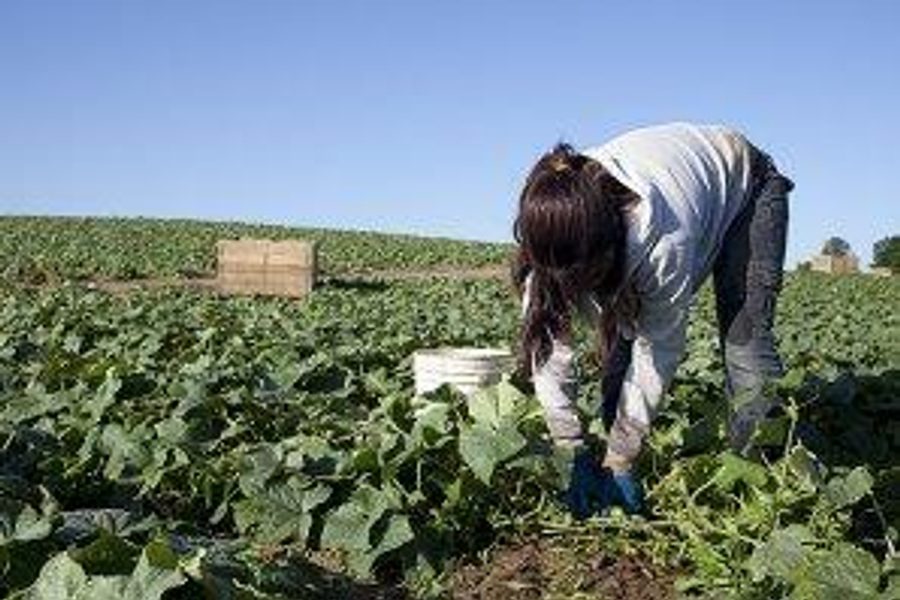
As kids around the country look forward to the start of summer break, it’s easy to forget that their mid-year vacation is actually curious relic of an earlier time, when children took time off to help out on the farm. Still, even in the post-industrial age, today’s farm sector continues to put kids to work, perpetuating one of the country’s last bastions of child labor.
It makes sense to employers: Kids make obedient field hands, their little fingers nimble enough to cull all those tiny berries with maximum efficiency. Moreover, the vast migrant labor force — largely Latino, impoverished and disenfranchised — is ripe for exploitation. But there’s a cost of doing this business, according to a new report from Human Rights Watch (HRW): disrupted schooling, safety hazards, and the threat of sexual assault, all factor into the opportunity cost of a lost childhood. (See video below.)
The extensive investigation reveals that child labor isn’t limited to Dickensian sweatshops in the “third world.” The federal labor laws that govern child farmworkers, moreover, don’t recognize that the agricultural sector has moved away from bucolic fields and toward modern-day plantation slavery.
Current U.S. regulations allow children as young as 12 to work on farms, and small farms have no minimum age if the child has parental permission. Toiling alongside their parents under brutal conditions, children are underpaid and exposed to injury and pesticide contamination. Young girls are “exceptionally vulnerable to sexual abuse.” For many, education and play time are impossible luxuries.
How many children work in U.S. fields each year? Due to the migratory and transient nature of the work, it’s a difficult question to answer, and data isn’t fresh; the HRW report notes that farmers in 2006 reported directly hiring 211,588 children under 18, and that nearly half a million children worked on their family’s farm that year. The total number toiling is likely much higher — the government estimates that 9 percent of all farmworkers hired in 2006 were under 18.
Child farm labor clusters in California, Florida, North Carolina, Texas, Oregon, and Washington State, though HRW stresses, “Virtually no state is without child labor in agriculture, and certainly no state fails to benefit from children’s farmwork, as the produce that is harvested and packed by youngsters’ hands may travel thousands of miles to grocery store shelves.” Even when subsidized by children’s wages, annual family incomes still hovered in the poverty range, “between $15,000 and $17,499” on average, according to 2005-2006 data.
Though the Obama administration has vowed to tighten enforcement, employers can easily flout the already weak labor rules. Some children start working at six or seven, getting a head start on the lifetime of misery to which their parents are often condemned:
Children, like many adult farmworkers, typically earn far less than minimum wage, and their pay is often further cut because employers underreport hours and force them to spend their own money on tools, gloves, and drinking water that their employers should provide by law.
The impacts on children’s development are difficult to grasp. Some of the youth interviewed reported regularly working from dawn till dusk, returning home utterly exhausted. But even then, said one girl, “I hated to sleep because sometimes all you dreamed of was working, thinking, ‘I need to be working.’” For a large portion of these workers, constant migration from site to site could lead to further social and emotional destabilization.
In an interview with HRW, a Michigan teen recalls, “[When I was 12] they gave me my first knife. Week after week I was cutting myself. Every week I had a new scar. My hands have a lot of stories.”
A mother reflected, “When you hear the children talk, you feel bad because you’ve taken a whole childhood away and you don’t realize it because you’re thinking about trying to make payments.”
About one-third of U.S.-born farmworkers (i.e. citizens) have dropped out of school—about four times the overall national rate — in large part because young people simply can’t complete their education as families shift from site to site. Federal support for migrant children’s education has reached only about half of the eligible population.
Stories like these abound, HRW reports, but the Department of Labor in 2009 “found only 36 cases of child labor violations involving 109 children in agriculture, constituting only 4 percent of all child labor cases that year. This number is not only astonishingly low, but also reflects a dramatic decline in overall enforcement of child labor laws from 2001.”
A proposed bill in Congress, the Children’s Act for Responsible Employment,would tighten regulations on child farm work and increase penalties for violations.
Yet beneath the day-to-day abuses these youth experience lies the economic structure of the food system, based on a byzantine regime of farm labor programs, an ample supply of migrants desperate for work, and the American consumer’s appetite for low prices at the checkout counter.
When viewed in light of the protests surrounding Arizona’s anti-immigrant law, these children represent all the reasons why criminalizing immigrants will do nothing to solve the crisis.
Many are U.S. citizens; many of their parents actually entered the country legally. Yet workers of all immigrant statuses are relegated to an employment system akin to indentured servitude. Child labor is the product of an immigration system that reduces families to a disposable workforce. For kids unable to contemplate a better life, their rights are the first to be thrown away.
Michelle Chen is a contributing writer at In These Times and The Nation, a contributing editor at Dissent and a co-producer of the “Belabored” podcast. She studies history at the CUNY Graduate Center. She tweets at @meeshellchen.








